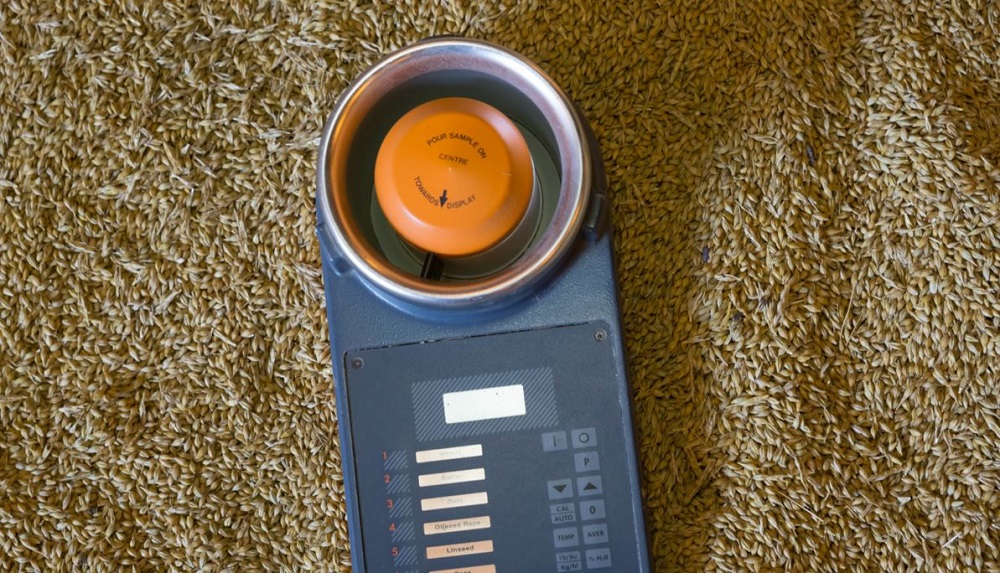- Home
- Knowledge library
- How to use a meter to measure grain moisture
How to use a meter to measure grain moisture
It is important to use appropriate and accurate – annually calibrated – equipment to assess grain moisture content. Follow these top tips to help your grain meet storage targets and minimise spoilage risks.
Accuracy and consistency of moisture meters
Meters measure moisture content indirectly, using grain resistance or capacitance. In the standard direct method (ISO/BSI ‘oven method’), a known weight of ground grain is dried at 130°C until dry matter weight remains constant.
Accuracy: A measurement of how closely a moisture meter reading matches the oven test. Accuracy is important to avoid spoilage or mycotoxin formation.
Consistency: Achieved when multiple tests of the same sample produce similar results.
The following guidance, which is based on an AHDB-funded project and practical experience, will help you collect accurate and consistent grain moisture content readings.
Use equipment as the manufacturer intended
Ensure calibration and maintenance is undertaken each year (ideally, by manufacturer). Always follow usage instructions. Ensure grain moisture is within the range of meter/probe. Poor operator practice may cause moisture meter errors of up to ±1%.
Use representative samples
Sample variability has the greatest influence on consistency (discrepancies of up to ±1%). Test samples that are representative of the bulk and free of contaminants (e.g. soil, screenings).
Be aware of moisture content variability
Keep samples in a watertight container, with minimum free air space, at an even air temperature. Mix each sample thoroughly before testing. However, be aware that moisture content variability potentially increases in freshly harvested grain, even within a well-mixed sample. AHDB research shows that grain (wheat and barley) with moisture contents at or above 18% tend to under-read by as much as 1%, with greater variability in freshly harvested grain. At around 15% MC, meters were usually within ±0.5% of the oven test. Repeat testing of the same sample gave meter readings within ±0.3%.
Account for temperature gradients
Allow sufficient time for meter/probe and grain temperatures to equilibrate. Errors of up to ±1% may occur when sample and meter temperatures differ by 15°C.
Prepare a good ground sample for resistance meters
Ensure that grinder is properly maintained – readings may be 1% lower with a worn grinder. Coarse grinding is sufficient and further grinding results in less accuracy. Compress ground sample as specified.
Use one calibration for UK wheat only
No differences were found using four meters to compare 20 wheat varieties – 13 with hard and 7 with soft endosperm. Where a meter had two calibrations for wheat, the soft calibration was the most accurate.
Use capacitance meters on a level surface
Use meters on level surfaces. Allow for a 0.4% moisture content increase (compared with the same samples reanalysed a week later) when analysing freshly dried grain with a capacitance meter.
Only use moisture probes for rapid assessments
Use probes to rapidly monitor the moisture content of grain within a bulk, but not in place of meters to assess moisture content of samples. Although not as accurate as meters in tests, probes gave consistent and reliable results. However, depth of insertion affected both types – low readings resulted at less than 0.5 m depth. Both types of probe – resistance and capacitance – were equally accurate, but resistance probes only gave a steady reading once probe and grain temperatures had stabilised after a minute or more.
Allow a safety margin
It is prudent to treat meter readings conservatively. Errors are frequently ±0.5% and can be greater in very wet, very dry or freshly harvested grain. Farmers who allow a 0.5% safety margin are far less likely to have claims for excess moisture.

Topics:
Sectors:
Tags:

